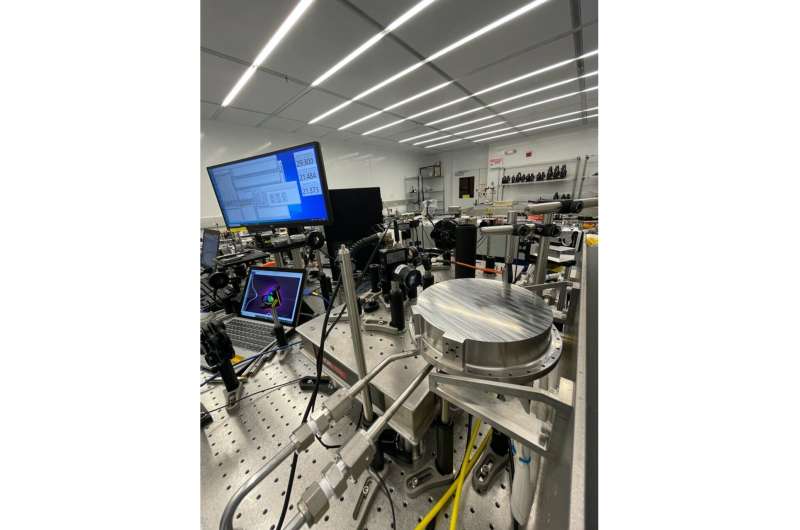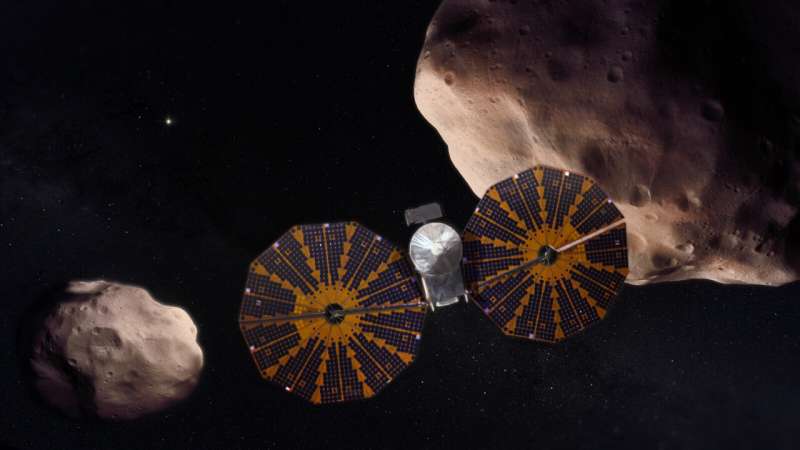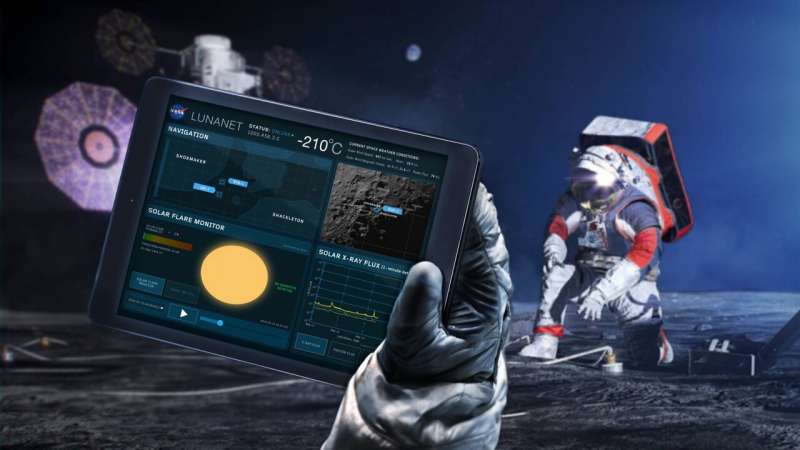
Copernical Team
Lasers to probe origin of life on a frigid moon and take the space-time pulse of star-shattering collisions

On Saturn's giant moon Titan, liquid methane and other hydrocarbons rain down, carving rivers, lakes and seas in a landscape of frozen water. The complex chemistry on this icy world could be analogous to the period when life first emerged on Earth, or it might yield an entirely new type of life.
NASA's Lucy mission: A journey to the young solar system

NASA's Lucy spacecraft will launch in October 2021 on a 12-year journey to Jupiter's Trojan asteroids. The Lucy mission will include three Earth gravity assists and visits to eight asteroids.
Called "Trojans" after characters from Greek mythology, most of Lucy's target asteroids are left over from the formation of the solar system. These Trojans circle the sun in two swarms: one that precedes and one that follows Jupiter in its orbit of the sun. Lucy will be the first spacecraft to visit the Trojans, and the first to examine so many independent solar system targets, each in its own orbit of the sun.
Studying Jupiter's Trojan asteroids up close would help scientists hone their theories on how our solar system's planets formed 4.5 billion years ago and why they ended up in their current configuration. "It's almost like we're traveling back in time," said aerospace engineer Jacob Englander, who helped design Lucy's trajectory while working at NASA's Goddard Space Flight Center in Greenbelt, Maryland.
First conceived seven years ago as a mission to two asteroids, Lucy expanded to epic proportions thanks to creative engineering and impeccable timing.
LunaNet: Empowering Artemis with communications and navigation interoperability

With Artemis, NASA will establish a long-term presence at the Moon, opening more of the lunar surface to exploration than ever before. This growth of lunar activity will require new, more robust communications, navigation, and networking capabilities. NASA's Space Communications and Navigation (SCaN) program has developed the LunaNet architecture to meet these needs.
LunaNet will leverage innovative networking techniques, standards, and an extensible framework to rapidly expand network capabilities at the Moon. This framework will allow industry, academia, and international partners to build and operate LunaNet nodes alongside NASA. These nodes will offer missions four distinct services: networking, navigation, detection and information, and radio/optical science services.
Networking
Typically, when missions launch into space, their communication down to Earth is reliant on pre-scheduled links with either a space relay or a ground-based antenna. With multiple missions journeying to the Moon, the reliance on pre-scheduled links could limit communications opportunities and efficiencies. LunaNet offers a network approach similar to the internet on Earth, where users maintain connections with the larger network and do not need to schedule data transference in advance.
First European map of the insulating effect of forests
 To cool off in summer, there's nothing better than a walk in the woods. Trees act as a buffer that cools the air beneath their foliage in summer and warms it in winter. This phenomenon is caused not only by the protection that the forest canopy provides, but also by the transpiration of trees in summer: trees absorb cooler water from the soil, and this water is then transported up to the leaves,
To cool off in summer, there's nothing better than a walk in the woods. Trees act as a buffer that cools the air beneath their foliage in summer and warms it in winter. This phenomenon is caused not only by the protection that the forest canopy provides, but also by the transpiration of trees in summer: trees absorb cooler water from the soil, and this water is then transported up to the leaves, Rare micrometeorite may have originated from a Ceres-like asteroid
 A micrometeorite, called TAM19B-7, may have originated from a Ceres-like asteroid, according to a recent study conducted by researchers Maitrayee Bose and Victoria Froh of Arizona State University, Martin Suttle of The Open University, U.K., and Luigi Folco, of the University of Pisa, Italy.
They will be presenting the results of their study at the 53rd annual American Astronomical Society
A micrometeorite, called TAM19B-7, may have originated from a Ceres-like asteroid, according to a recent study conducted by researchers Maitrayee Bose and Victoria Froh of Arizona State University, Martin Suttle of The Open University, U.K., and Luigi Folco, of the University of Pisa, Italy.
They will be presenting the results of their study at the 53rd annual American Astronomical Society China's Mars probes suspend explorations due to Sun outage
 China's Mars rover and orbiter have suspended explorations since mid-September, to wait out a period of sun outage, the China National Space Administration said on Tuesday.
A sun outage refers to a phenomenon when Mars and the Earth move to either side of the sun and the three are almost perfectly aligned. During this period, the solar electromagnetic radiation will increase and disrupt th
China's Mars rover and orbiter have suspended explorations since mid-September, to wait out a period of sun outage, the China National Space Administration said on Tuesday.
A sun outage refers to a phenomenon when Mars and the Earth move to either side of the sun and the three are almost perfectly aligned. During this period, the solar electromagnetic radiation will increase and disrupt th Student experiments float over New Mexico
 University students from North and South America put their classroom knowledge and technical skills to the test when their experiments flew on a recent NASA scientific balloon flight over New Mexico.
Launched Sept. 14 from Fort Sumner, New Mexico, the balloon carried the High-Altitude Student Platform or HASP, with its 11 student experiments and also 23 student experiments through the Rock
University students from North and South America put their classroom knowledge and technical skills to the test when their experiments flew on a recent NASA scientific balloon flight over New Mexico.
Launched Sept. 14 from Fort Sumner, New Mexico, the balloon carried the High-Altitude Student Platform or HASP, with its 11 student experiments and also 23 student experiments through the Rock Simulating space on Earth: NASA receives hardware for testing satellite servicing tech
 In August 2021, new testing equipment arrived at NASA's Goddard Space Flight Center in Greenbelt, Maryland, in the form of a gravity offset table. NASA engineers will use the table to test robotic satellite servicing technologies that will one day operate in space.
A gravity offset table is a large piece of granite used for testing space payloads in simulated zero-gravity conditions. Measu
In August 2021, new testing equipment arrived at NASA's Goddard Space Flight Center in Greenbelt, Maryland, in the form of a gravity offset table. NASA engineers will use the table to test robotic satellite servicing technologies that will one day operate in space.
A gravity offset table is a large piece of granite used for testing space payloads in simulated zero-gravity conditions. Measu Eutelsat raises its shareholding in OneWeb
 Eutelsat Communications has exercised a call option on a portion of the latest OneWeb funding round subscribed by Bharti, for a consideration of $165 million, taking its shareholding from 17.6% to 22.9%.
The transaction was undertaken on identical financial terms to Eutelsat's initial investment of $550 million announced in April and completed on 8 September. The completion of this latest
Eutelsat Communications has exercised a call option on a portion of the latest OneWeb funding round subscribed by Bharti, for a consideration of $165 million, taking its shareholding from 17.6% to 22.9%.
The transaction was undertaken on identical financial terms to Eutelsat's initial investment of $550 million announced in April and completed on 8 September. The completion of this latest NASA scientist looks to AI, lensing to find masses of free-floating planets
 Exoplanet hunters have found thousands of planets, most orbiting close to their host stars, but relatively few alien worlds have been detected that float freely through the galaxy as so-called rogue planets, not bound to any star. Many astronomers believe that these planets are more common than we know, but that our planet-finding techniques haven't been up to the task of locating them.
Mo
Exoplanet hunters have found thousands of planets, most orbiting close to their host stars, but relatively few alien worlds have been detected that float freely through the galaxy as so-called rogue planets, not bound to any star. Many astronomers believe that these planets are more common than we know, but that our planet-finding techniques haven't been up to the task of locating them.
Mo 